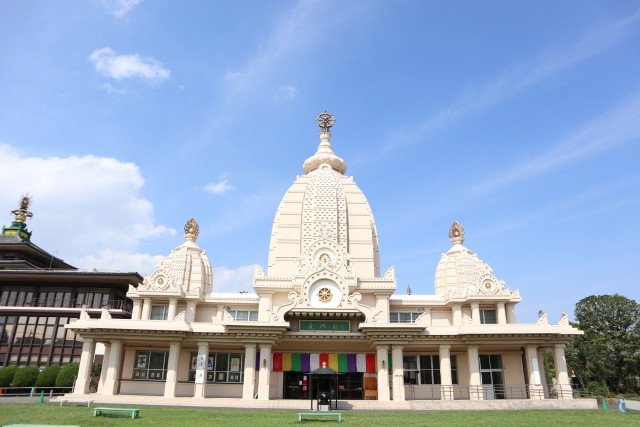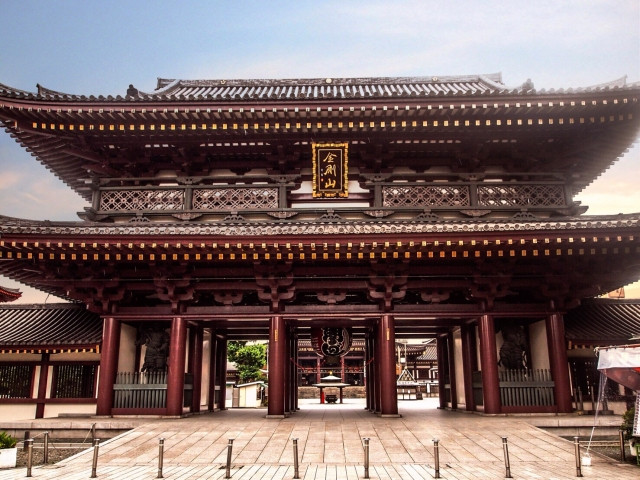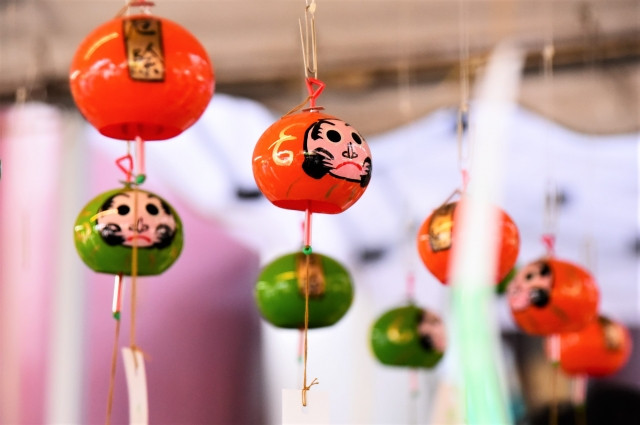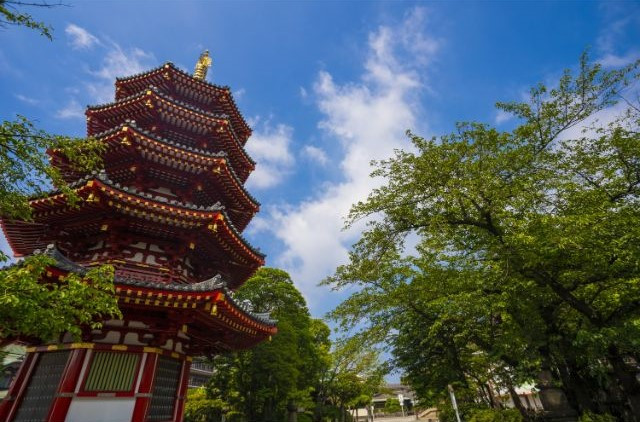Kawasaki Daishi, official name Heiken-Ji, is a popular temple for Hatsumode in Kawasaki City of Kanagawa Prefecture. The temple’s highlights include its burning rituals, Hakkaku Gajunoto - a vermillion octagonal five story pagoda, and Yasuragi Bridge - a red bridge over a blue pond which brings good luck if you cross it.
Table of Contents
- Origins of Kobo Daishi Temple
- Important Structures to See
- Fun Facts about Kawasaki Daishi
- Celebrations and Events at Kawasaki Daishi
- Access to Kawasaki Daishi
- Summary
Origins of Kobo Daishi Temple

Kawasaki Daishi Heikenji is in fact not only one of the biggest temples of Chisan School, it is also its Grand Head Temple. It was constructed during the rule of Emperor Sutoku at the end of the Heian Period. It all began when a samurai named Hirama Kanenori was unfairly exiled from his homeland and chose to settle down in Kawasaki working as a fisherman to make ends meet. Despite his many sufferings, he remained a devout Buddhist, to the teachings of Kobo Daishi in particular.
One night, he dreamt of a great priest who told him to fish out a statue of Kobo Daishi on his next fishing trip. By worshipping this image, the samurai and others who followed him would receive fortune and blessings, so said the priest in his dream. Hirama did as his dream said, drawing in the Kobo Daishi statue with his fishing net. The statue would go on to become the principal image of the temple.
Time passed until a renowned Buddhist priest Sonken came across the samurai and his Kobo Daishi statue. Entranced by the figure, the two began the construction of the Kawasaki Daishi Temple that we know today.
※ Kawasaki Daishi, “History”
Writer's Pick
Important Structures to See

The buildings that make up Kawasaki Daishi are representative of architecture from the Heian period. Although most of these buildings are not original, having been destroyed during World War II. The temple was rebuilt after the end of the war. Great effort was made to recreate its original architecture.
Kawasaki Daishi’s Most Important Structures include:
-
Dai-Hondo 大本堂
The main hall, home to the temple’s principal image, the sacred statue of Kobo Daishi. -
Dai-Sanmon 大山門
The main gate which acts as the entrance to the temple grounds. Statues of the Four Heavenly Kings, as guardians of the temple, can be found here. -
Hakkaku Gojunoto 八角五重塔
This is one of the temple's most famous structures - the octagonal five-story pagoda. The 5 tiers of the pagoda represent the five elements of water, fire, earth, wind, and metal.
Why is it octagonal? It is the closest buildable shape to “circle” at that time representing completeness and openness. -
Yasuragi Bridge やすらぎ橋
Painted a vermillion red representing prosperity as well as a ward against evil, crossing this bridge is said to bring luck. -
Henro Daishi 遍路大師
A statue of Kobo Daishi representing his completion of the Shikoku 88 pilgrimage route. The pillars around the statue stand on sand taken from each of the 88 spots on the route.
You can read about the other structures here.
Fun Facts about Kawasaki Daishi

-
Kawasaki Daishi is not the temple’s official name. Its formal name is actually Kongozan Kinjoin Heiken-ji (金剛山金乗院平間寺). So it is sometimes referred to as Heiken-ji.
-
Even celebrities visit the temple for Hatsumode, the first temple visit of the year! In fact, roughly 3 million people visit Kawasaki Daishi annually for Hatsumode, making it one of the most popular locations to do so.
-
The temple performs daily yakuyoke (厄除け), or purification through Gomakitou (護摩祈禱), a burning ritual to pray for prosperity and peace. The ritual performed on the first and last day of the year is extra special.
-
The temple performs prayers and blessings for traffic safety. What makes this temple unique is that your car will undergo a purification ceremony - you’d need to literally drive your car up to Jidosha Kotsuanzen Kitoden (自動車交通安全祈祷殿).
-
Have a Goshuincho (御朱印帳)? You will be glad to know you can collect 8 different types of temple stamps at Kawasaki Daishi. The stamps are available at the main hall (大本堂), Fudo-do (不動堂), Yakushi-den (薬師殿), Jidosha Kotsuanzen Kitoden (自動車交通安全祈祷殿), and Ogoma Uketsukejyo (護持志納受付所).
※ Kawasaki Daishi, “Goshuin”
Celebrations and Events at Kawasaki Daishi

In line with its fame and importance, Kawasaki Daishi is host to several big events throughout the year. These are some of their most popular crowd-gathering events:
Setsubun
Kawasaki Daishi is one of several options in Kanagawa to experience Setsubun celebrations in a temple. They get quite serious about the festivities, including major bean-throwing. Not sure what Setsubun is about? Check our dedicated article:
Gohonzon Kobo-Daishi Gotan Hoshukue (御本尊弘法大師降誕奉祝会)
A remembrance ceremony held outdoors in honor of Kobo Daishi’s day of birth, 15 June 774. Even though Kobo Daishi’s birthday is in June, the temple celebrates in May due to the monsoon season that typically starts in June.
Furin-Ichi (風鈴市)
Windchimes (furin) are a summer thing. Studies show that listening to the tinkling sound of the bells will make one physically cooler, though limited to those brought up with windchimes in their childhood. The psychology to physical effect is similar to Pavlov classical conditioning. Interesting right?
Summer event furin-ichi brings together windchimes from all over the country. There will be dancing on temple grounds, and most visitors will be dressed in summer yukata.
Access to Kawasaki Daishi
-
From Keikyu Kawasaki Station, take a train on the Keikyu Daishi Line to Kawasaki Daishi Station, then walk for 6-mins. (140 yen)
-
From JR Kawasaki Station, take the local bus to Kannon 2-chome Kawasaki Daishi-guchi (観音二丁目川崎大師口) Bus Station, then walk for 5-mins. (210 yen)
Keikyu Kawasaki Station is a short walking distance from JR Kawasaki if you’re looking to save 70 yen.
Summary

Heiken-ji, more commonly known as Kawasaki Daishi is an incredibly important temple in Japan, with both historical and cultural influence even today. Come here for the beautiful sights and rituals to protect yourself, or come for the annually celebrated events that the temple is also known for, including Hatsumode, Setsubun and the windchime festival!
※Kawasaki Daishi Heikenji Temple
For other things to do in Kawasaki, check our dedicated article:









.jpg)



















